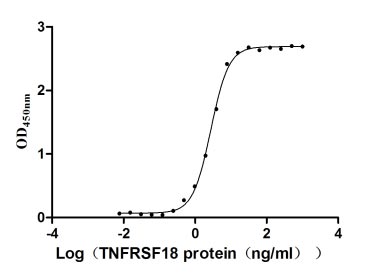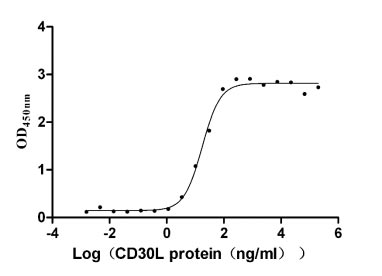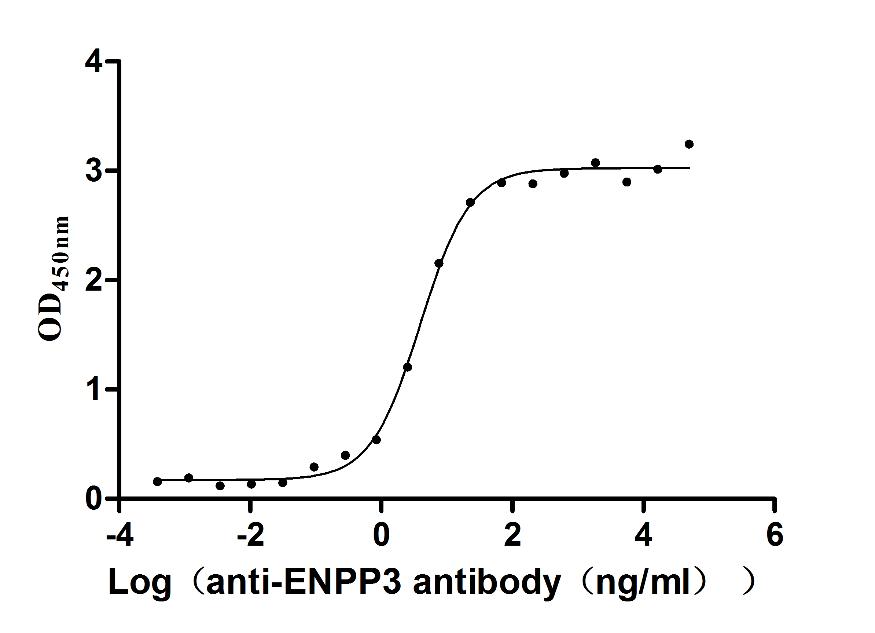Recombinant Mouse Elongation of very long chain fatty acids protein 4 (Elovl4), partial
-
中文名称:小鼠Elovl4重组蛋白
-
货号:CSB-YP861676MO1
-
规格:
-
来源:Yeast
-
其他:
-
中文名称:小鼠Elovl4重组蛋白
-
货号:CSB-EP861676MO1
-
规格:
-
来源:E.coli
-
其他:
-
中文名称:小鼠Elovl4重组蛋白
-
货号:CSB-EP861676MO1-B
-
规格:
-
来源:E.coli
-
共轭:Avi-tag Biotinylated
E. coli biotin ligase (BirA) is highly specific in covalently attaching biotin to the 15 amino acid AviTag peptide. This recombinant protein was biotinylated in vivo by AviTag-BirA technology, which method is BriA catalyzes amide linkage between the biotin and the specific lysine of the AviTag.
-
其他:
-
中文名称:小鼠Elovl4重组蛋白
-
货号:CSB-BP861676MO1
-
规格:
-
来源:Baculovirus
-
其他:
-
中文名称:小鼠Elovl4重组蛋白
-
货号:CSB-MP861676MO1
-
规格:
-
来源:Mammalian cell
-
其他:
产品详情
-
纯度:>85% (SDS-PAGE)
-
基因名:Elovl4
-
Uniprot No.:
-
别名:Elovl4; Elongation of very long chain fatty acids protein 4; 3-keto acyl-CoA synthase Elovl4; ELOVL fatty acid elongase 4; ELOVL FA elongase 4; Very long chain 3-ketoacyl-CoA synthase 4; Very long chain 3-oxoacyl-CoA synthase 4
-
种属:Mus musculus (Mouse)
-
蛋白长度:Partial
-
蛋白标签:Tag type will be determined during the manufacturing process.
The tag type will be determined during production process. If you have specified tag type, please tell us and we will develop the specified tag preferentially. -
产品提供形式:Lyophilized powder
Note: We will preferentially ship the format that we have in stock, however, if you have any special requirement for the format, please remark your requirement when placing the order, we will prepare according to your demand. -
复溶:We recommend that this vial be briefly centrifuged prior to opening to bring the contents to the bottom. Please reconstitute protein in deionized sterile water to a concentration of 0.1-1.0 mg/mL.We recommend to add 5-50% of glycerol (final concentration) and aliquot for long-term storage at -20℃/-80℃. Our default final concentration of glycerol is 50%. Customers could use it as reference.
-
储存条件:Store at -20°C/-80°C upon receipt, aliquoting is necessary for mutiple use. Avoid repeated freeze-thaw cycles.
-
保质期:The shelf life is related to many factors, storage state, buffer ingredients, storage temperature and the stability of the protein itself.
Generally, the shelf life of liquid form is 6 months at -20°C/-80°C. The shelf life of lyophilized form is 12 months at -20°C/-80°C. -
货期:Delivery time may differ from different purchasing way or location, please kindly consult your local distributors for specific delivery time.Note: All of our proteins are default shipped with normal blue ice packs, if you request to ship with dry ice, please communicate with us in advance and extra fees will be charged.
-
注意事项:Repeated freezing and thawing is not recommended. Store working aliquots at 4°C for up to one week.
-
Datasheet :Please contact us to get it.
相关产品
靶点详情
-
功能:Catalyzes the first and rate-limiting reaction of the four reactions that constitute the long-chain fatty acids elongation cycle. This endoplasmic reticulum-bound enzymatic process allows the addition of 2 carbons to the chain of long- and very long-chain fatty acids (VLCFAs) per cycle. Condensing enzyme that catalyzes the synthesis of very long chain saturated (VLC-SFA) and polyunsaturated (PUFA) fatty acids that are involved in multiple biological processes as precursors of membrane lipids and lipid mediators. May play a critical role in early brain and skin development.
-
基因功能参考文献:
- these studies establish a critical, novel role for ELOVL4 and its VLC-SFA products in regulating synaptic release kinetics and epileptogenesis. PMID: 29168048
- The abnormal presence of ELOVL4 protein in POSs results in phagosomes that are defective in recruiting appropriate motor protein linkers, thus contributing to slower degradation because their altered motility results in slower basal migration and fewer productive encounters with endolysosomes. PMID: 29735674
- ELOVL4 is significantly reduced in the diabetic retina. PMID: 29362226
- mutations in the ELOVL4 gene lead to cone degeneration in humans, whereas mouse models expressing the mutant Elovl4 show predominant rod degeneration PMID: 29293603
- Studies indicate that Knock-IN and Knock-OUT strains of ELOVL4 (STGD3) model development has been to unveil the causal connection between the genotype and early-onset progressive cone degeneration in humans. PMID: 26427404
- ELOVL4 enzymatic activity is governed by individual histidines in its active site and the endoplasmic reticulum microenvironment. PMID: 24569140
- To elucidate the role of VLC-PUFAs in photoreceptor terminals, we conditionally deleted Elovl4 in rod and cone photoreceptors of mice and measured inner retina function, synaptic connectivity, and ultrastructure of rod terminals with reduced VLC-PUFAs. PMID: 24764063
- expression and outer segment mislocalization of the disease-linked 5-base-pair deletion mutant ELOVL4 protein alters photoreceptor structure and function PMID: 24833735
- The mosaic deletion of rod-expressed ELOVL4 protein resulted in a 36 % lower amount of very long chain-PUFA in the retinal phosphatidylcholine (PC) fraction compared to retinas from wild-type mice. PMID: 24664753
- ELOVL4 was strongly expressed within the holocrine meibomian and sebaceous glands but no ELOVL4 was detected within the central meibomian duct. PMID: 24677106
- the presence of the mutant ELOVL4 does not affect the function of wild-type ELOVL4 in the fully developed 8- to 10-week-old retinas. PMID: 24644051
- Role of ELOVL4 and very long-chain polyunsaturated fatty acids in mouse models of Stargardt type 3 retinal degeneration. PMID: 23479632
- the critical role of Elovl4 for proper rod or cone photoreceptor function PMID: 22199362
- Epidermal expression of an Elovl4 transgene rescues neonatal lethality of homozygous Stargardt disease-3 mice. PMID: 21429867
- ELOVL4 protein is not involved in docosahexaenoic acid biosynthesis from the short chain fatty acid precursors 18:3n3 and 22:5n3. PMID: 20238022
- deficit leads to the human STGD3 pathology. PMID: 17983602
- The ELOVL4 gene is highly conserved throughout evolution and is expressed in the photoreceptor cells of the retina in a variety of different species PMID: 12824221
- Elovl4 expression in developing retina follows a dynamic pattern. It switches from predominant ganglion cell expression in embryonic and early postnatal development to predominant expression in the photoreceptor inner segments PMID: 12847421
- ELOVL4 may play an important role in embryonic development and in maintaining normal physiology of retina and brain at later stages of development PMID: 15028285
- These findings demonstrate that ELOVL4 is required for generating very long-chain fatty acids critical for epidermal barrier function, and that the lack of epidermal omega-O-acylceramides is incompatible with survival in a desiccating environment. PMID: 17208947
- These results implicate the importance of these long chain fatty acids in skin barrier development. Furthermore, we suggest that Elovl4 is likely involved in the elongation of C26 and longer fatty acids. PMID: 17304340
- These data demonstrate that ELOVL4 is required for very long chain fatty acid synthesis that is essential for water permeability barrier function of skin. PMID: 17311087
- Mouse models of genetic macular degeneration include studies on Elovl4. PMID: 17368622
- deficit leads to the human STGD3 pathology PMID: 17983602
- Role of Elovl4 in fatty acid metabolism is reported. PMID: 18188956
- ELOVL4 is required for the synthesis of C28 and C30 saturated fatty acids (VLC-FA) and of C28-C38 very long chain polyunsaturated fatty acids (VLC-PUFA). PMID: 18728184
显示更多
收起更多
-
亚细胞定位:Endoplasmic reticulum membrane; Multi-pass membrane protein.
-
蛋白家族:ELO family, ELOVL4 subfamily
-
组织特异性:Expressed in the retina, exclusively in photoreceptor cells and in the brain, skin, testis and lens.
-
数据库链接:
KEGG: mmu:83603
STRING: 10090.ENSMUSP00000034796
UniGene: Mm.83949
Most popular with customers
-
Recombinant Human Tumor necrosis factor receptor superfamily member 18 (TNFRSF18), partial (Active)
Express system: Mammalian cell
Species: Homo sapiens (Human)
-
Recombinant Human Tumor necrosis factor receptor superfamily member 8 (TNFRSF8), partial (Active)
Express system: Mammalian cell
Species: Homo sapiens (Human)
-
Express system: Mammalian cell
Species: Macaca fascicularis (Crab-eating macaque) (Cynomolgus monkey)
-
Recombinant Human Claudin-4 (CLDN4)-VLPs (Active)
Express system: Mammalian cell
Species: Homo sapiens (Human)
-
Recombinant Human Claudin-3 (CLDN3)-VLPs (Active)
Express system: Mammalian cell
Species: Homo sapiens (Human)
-
Recombinant Mouse Cytotoxic and regulatory T-cell molecule (Crtam), partial (Active)
Express system: Mammalian cell
Species: Mus musculus (Mouse)
-
Recombinant Human Cadherin-6(CDH6),partial (Active)
Express system: Mammalian cell
Species: Homo sapiens (Human)



















